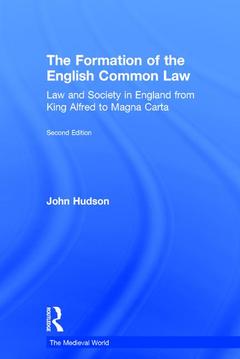Description
The Formation of the English Common Law (2nd Ed.)
Law and Society in England from King Alfred to Magna Carta
The Medieval World Series
Author: Hudson John
Language: English
Subjects for The Formation of the English Common Law:
Keywords
Angevin Reforms; Royal Justices; Anglo-Norman; Anglo-Norman Period; king's court; shire courts; Shire Court; urban courts; Lord King; Ecclesiastical courts; Plea Rolls; violence; Henry II's Reign; theft; Late Anglo-Saxon; punishment; Leges Henrici; land-holding; Fonthill Letter; Angevin; Closest Heir; King Stephen; Itinerant Justices; Henry II; Stephen's Reign; crime; Angevin Period; Angevin reform; Seignorial Courts; Magna Carta; Grand Assize; King John; Young Man; Alfred the Great; Papal Judge Delegate; Anglo-Norman England; Royal Remedies; Royal Administration; Leges Henrici Primi; Fee Farm; Dialogue Of The Exchequer
Publication date: 08-2017
· 15.6x23.4 cm · Hardback
Publication date: 08-2017
· 15.6x23.4 cm · Paperback
Description
/li>Contents
/li>Readership
/li>Biography
/li>
The Formation of English Common Law provides a comprehensive overview of the development of early English law, one of the classic subjects of medieval history. This much expanded second edition spans the centuries from King Alfred to Magna Carta, abandoning the traditional but restrictive break at the Norman Conquest. Within a strong interpretative framework, it also integrates legal developments with wider changes in the thought, society, and politics of the time.
Rather than simply tracing elements of the common law back to their Anglo-Saxon, Norman or other origins, John Hudson examines and analyses the emergence of the common law from the interaction of various elements that developed over time, such as the powerful royal government inherited from Anglo-Saxon England and land holding customs arising from the Norman Conquest.
Containing a new chapter charting the Anglo-Saxon period, as well as a fully revised Further Reading section, this new edition is an authoritative yet highly accessible introduction to the formation of the English common law and is ideal for students of history and law.
Editor’s Preface to First Edition
Author’s Preface to First Edition
Author’s Preface to Second Edition
Abbreviations
CHAPTER 1 Introduction
The concept of law
The functions of law
Disputing and negotiating
English common law
The formation of the English common law
CHAPTER 2 The Court Framework in Anglo-Saxon and Anglo-Norman England
The king’s court
Local and itinerant justices
Shire courts
Hundred courts
Seignorial courts
Urban courts
Ecclesiastical courts
Conclusions
CHAPTER 3 Violence and Theft in Anglo-Saxon and Anglo-Norman England
Bricstan’s case
Offences, offenders, and motives
Prevention and police
Trial
Punishment and compensation
Conclusions
CHAPTER 4 Law and Land-holding in Anglo-Saxon England
Æscwynn of Stonea, Ogga of Mildenhall, Wulfstan of Dalham and their gifts to the church of Ely
The forms of land
Land, lordship, and law
The customary framework
Disputes
Conclusions
CHAPTER 5 Law and Land-holding in Anglo-Norman England
Land, lordship, and law
The forms of land-holding
The customary framework: control of land held in fee
Disputes
Anglo-Norman land law and common law property
Conclusions
CHAPTER 6 Angevin Reform
Kingship, Stephen’s reign, and Angevin reform
The eyre
Chronology
The stages and nature of reform
Henry II and reform
The administrator’s mentality
Conclusions
CHAPTER 7 Crime and the Angevin Reforms
Ailward’s case
Classification
The continuation of traditional methods
Presentment and the extension of royal authority
The limits of royal authority
Conclusions
CHAPTER 8 Law and Land-holding in Angevin England
Abbot Samson of Bury St Edmunds
New procedures
The impact of change
Conclusions
CHAPTER 9 Magna Carta and the Formation of the English Common Law
King John and the administration of justice
Magna Carta
Law and legal expertise
The common law
Concluding comparisons
Glossary
Note on sources
Further reading
Index
John Hudson is Professor of Legal History at St Andrews University, UK, and William W. Cook Global Law Professor at the University of Michigan. His previous publications include F. W. Maitland and the Englishness of English Law(2008), The Oxford History of the Laws of England, Volume II 871-1216 (2012) and Papers Preparatory to the Making of English Law: King Alfred to the Twelfth Century, Volume II: From God's Law to Common Law, ed., with Stephen Baxter (2014).




